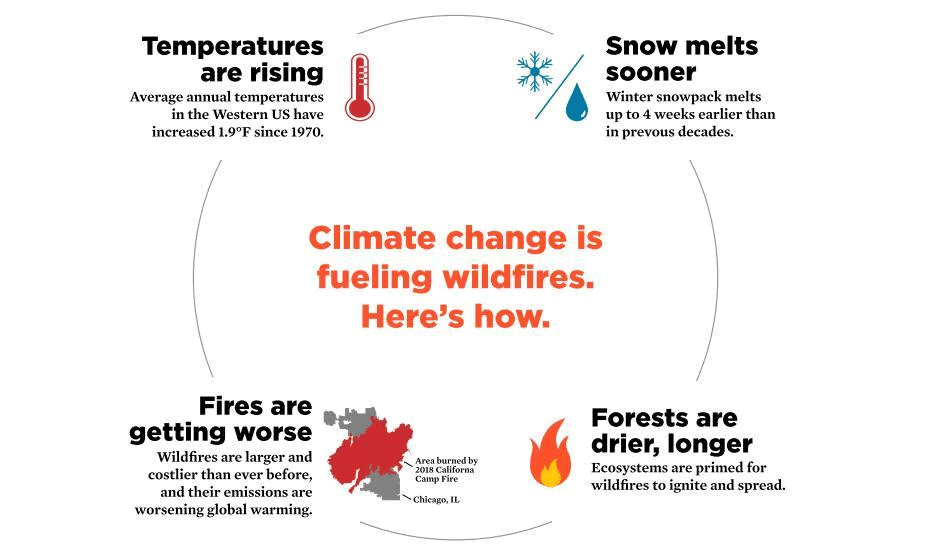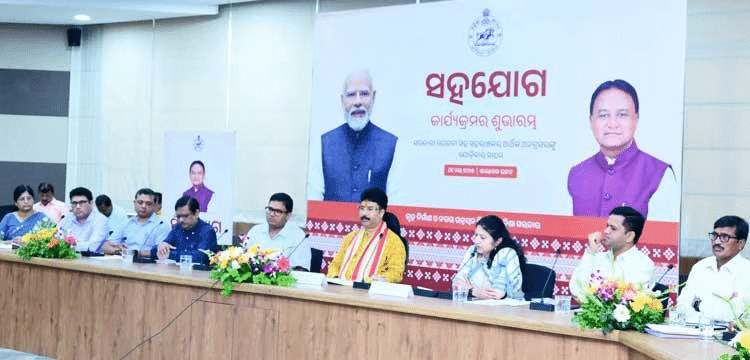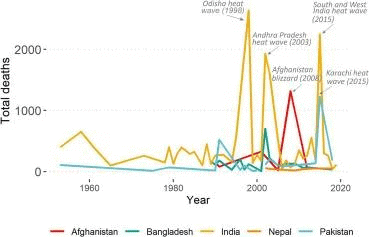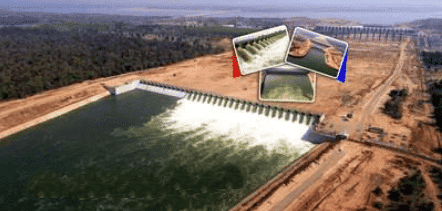Weekly Current Affairs (1st to 7th May 2025) | General Test Preparation for CUET UG - CUET Commerce PDF Download
Climate Change and Fire Seasons
 Why in News?
Why in News?
- Climate change is significantly increasing the risk of wildfires worldwide. Recent studies highlight that fire weather seasons in eastern Australia and western North America are increasingly overlapping, complicating international cooperation among fire services in Canada, the United States, and Australia.
Key Takeaways
- Fire weather seasons are overlapping due to climate change, causing challenges for international firefighting efforts.
- The Canadian Fire Weather Index (FWI) is a global tool for assessing wildfire risk.
- Future projections indicate an increase in overlapping fire weather days by 4 to 29 days annually by 2050.
Additional Details
- Fire Weather Conditions: Fire weather signifies specific atmospheric conditions that facilitate the spread of wildfires. Key factors include:
- Temperature
- Humidity
- Rainfall
- Wind Speed
- Historical Context: Traditionally, fire seasons in western North America occurred from June to October, while eastern Australia's season ran from October to March, allowing for effective resource sharing during emergencies.
- Overlapping Fire Weather Days: Research indicates a rise in overlapping fire weather days, increasing by one day each year since 1979, with peak overlap between July and December occurring 75% of the time.
- Role of El Niño and La Niña:
- El Niño: Associated with warmer Pacific Ocean temperatures, leading to droughts and fires in Australia.
- La Niña: Linked to cooler Pacific Ocean temperatures, contributing to fires in North America.
- International Cooperation: Australia, the USA, and Canada collaborate in firefighting efforts, sharing resources like personnel, aircraft, and equipment. However, overlapping fire seasons are reducing the time available for support.
- Recommendations for Firefighting Strategies: Countries should enhance firefighting capabilities through investments in equipment and training for local fire services. Revisiting international agreements on resource sharing is crucial to adapt to changing wildfire risks.
In conclusion, the intensification of climate change is leading to significant changes in fire weather seasons, necessitating a reassessment of international collaboration and firefighting strategies to effectively combat the growing risk of wildfires.
Supreme Court’s Limited Powers on Arbitral Awards
 Why in News?
Why in News?
- On May 1, 2025, the Supreme Court of India delivered a significant ruling that clarifies the extent of judicial powers concerning arbitral awards under the Arbitration and Conciliation Act of 1996. This ruling was made by a Constitution Bench led by Chief Justice Sanjiv Khanna and addresses a reference made in February 2024 regarding the interpretation of Sections 34 and 37 of the Act.
Key Takeaways
- The Supreme Court established that appellate courts have limited authority to modify arbitral awards.
- Modifications are allowed only under specific conditions, such as when awards are severable.
- Corrections of clerical, computational, or typographical errors in awards are permissible.
- Post-award interest can be modified under certain circumstances.
Additional Details
- Section 34: Governs the setting aside of arbitral awards, outlining the grounds for annulment.
- Section 37: Details the appeals process related to orders in arbitral disputes.
- Justice K.V. Viswanathan dissented, arguing that Section 34 should not allow for modifications, as this could undermine the arbitration process, especially in international contexts.
- The ruling aims to preserve the integrity of arbitration as a dispute resolution mechanism.
The Supreme Court's decision invites further discussion on the need for legislative clarity regarding the powers of courts over arbitral awards, indicating that the potential for modifications remains a contentious issue that may require future legislative intervention.
India’s Record-Breaking Warm Year
 Why in News?
Why in News?
- The India Meteorological Department (IMD) has declared that 2024 was the warmest year recorded in India’s history, with an average surface temperature anomaly of +0.65°C above the long-term average. However, there are concerns that actual warming could have surpassed the critical threshold of 1°C, primarily due to changes in the Long Period Average (LPA) used for comparison.
Key Takeaways
- 2024 marked a significant increase in temperature anomalies compared to historical averages.
- Changes in the LPA by IMD have implications for how temperature anomalies are reported and interpreted.
- Extreme weather events have notably increased, impacting a large portion of the population and agricultural land.
Additional Details
- Long Period Average (LPA): The LPA is defined as the average temperature over a 30-year period, which is crucial for assessing climate trends. IMD has revised the LPA several times:
- 1961-1990 average was the initial baseline.
- In 2016, it changed to the 1971-2000 average.
- In 2019, it was updated to the 1981-2010 average.
- Most recently, in 2024, it was set to the 1991-2020 average.
- Transparency Issues: IMD's annual reports do not disclose actual recorded temperatures or LPA values, only the anomalies. This lack of transparency complicates the tracking of temperature trends and raises questions about data validity.
- Extreme Weather Events: In 2024, India experienced extreme weather on 322 days, affecting nearly 88% of the country, leading to 3,472 fatalities.
- Impact on Agriculture: Over 4.07 million hectares of cropped land were affected by extreme weather, marking an 84% increase from the previous year, particularly impacting Central India.
The alarming rise in temperature anomalies and the frequency of extreme weather events highlight the urgent need for effective climate action and transparent data reporting to better understand and address the impacts of climate change in India.
Sahajog Initiative
 Why in News?
Why in News?
- The Odisha government recently inaugurated the Sahajog initiative on May 1, 2025. This innovative program aims to improve access to government welfare schemes for urban poor populations, addressing the disconnect between urban poverty and available state support.
Key Takeaways
- Sahajog targets urban poor families to connect them with essential welfare schemes.
- The program will run in a campaign mode from May 1 to June 20, 2025, covering 44 Urban Local Bodies (ULBs).
- Approximately 15 lakh residents across eight districts will benefit from this initiative.
Additional Details
- Implementation Strategy: The initiative will operate in a campaign mode for a specified period, focusing on comprehensive outreach to urban communities.
- Welfare Schemes Included: Sahajog encompasses 14 crucial welfare schemes, including the Pradhan Mantri Awas Yojana (Urban), ration cards under the National Food Security Act, and Ayushman Cards.
- Community Engagement: Volunteers and frontline workers will receive performance-based incentives to ensure effective execution of the program.
- Coordination Mechanisms: Interdepartmental committees will be established to facilitate smooth coordination at both state and district levels.
- Future Expansion Plans: Post-initial phase, Sahajog is expected to expand to cover all ULBs across Odisha based on feedback and outcomes from the first phase.
- Alignment with Broader Goals: The initiative aligns with Odisha's developmental goals, supporting the Viksit Odisha and Viksit Bharat missions to foster inclusive growth.
In summary, Sahajog marks a significant step towards enhancing the delivery of welfare services to urban poor communities in Odisha, ensuring that eligible beneficiaries can access crucial government assistance effectively.
Challenges in PMLA Case Trials in India
 Why in News?
Why in News?
- The Enforcement Directorate (ED) has highlighted ongoing issues affecting the timely resolution of money laundering case trials in India. Despite the establishment of 100 special courts under the Prevention of Money Laundering Act (PMLA), various systemic and procedural challenges continue to impede progress. The ED's recent annual report provides insights into these challenges.
Key Takeaways
- Systemic challenges delay the prosecution of money laundering cases.
- Judicial resource constraints lead to interruptions in trials.
- The conviction rate reported by the ED stands at 93.6%.
- Significant legal challenges exist regarding asset attachment.
- Management of attached assets poses additional challenges for the ED.
- Recent performance metrics indicate a marked increase in provisional attachments.
Additional Details
- Systemic and Procedural Hurdles: The ED report points out that the prosecution of money laundering cases often depends on the progress of related predicate offences. Delays in these cases can significantly prolong PMLA trials. The complexities of financial investigations, particularly those involving intricate financial structures and cross-border transactions, add to the challenge.
- Judicial Resource Constraints: Many special PMLA courts also handle cases under multiple statutes, resulting in trial interruptions due to interlocutory applications and writ petitions. Such delays can escalate to higher courts, further prolonging proceedings.
- Conviction Rate and Case Statistics: The ED's report shows a high conviction rate of 93.6%, with only three acquittals out of 47 decided cases. Since 2005, the ED has filed 1,739 prosecution complaints out of 7,771 registered Enforcement Case Information Reports (ECIRs).
- Legal Challenges in Asset Attachment: Approximately one-third of the ₹1.54 lakh crore in proceeds of crime faces legal challenges. The ED deals with issues regarding the validity of confirmation orders by a single adjudicating authority, leading to asset freezes worth ₹3,803.91 crore.
- Management of Attached Assets: The ED faces difficulties in managing attached properties, which may depreciate over time. To mitigate value loss, the agency occasionally substitutes these assets with fixed deposit receipts.
- Recent Performance Metrics: In the 2024-25 period, the ED issued 416 provisional attachment orders totaling ₹30,036 crore, marking a 44% increase in the number of attachments and a 141% rise in total value compared to the previous year.
In summary, while the ED is actively pursuing the reclamation of proceeds from crime, systemic hurdles and judicial constraints continue to challenge the timely adjudication of PMLA cases. The agency's commitment to tackling these issues remains critical in reinforcing the fight against money laundering in India.
Rising Temperatures and Mortality Trends in India
 Why in News?
Why in News?
- Recent studies have uncovered troubling mortality trends in India linked to extreme temperatures. Over the last two decades, approximately 35,000 deaths have been attributed to both heat and cold exposure, highlighting the urgent need for strategic policies aimed at mitigating these risks.
Key Takeaways
- Heatstroke accounts for more deaths compared to cold exposure, particularly affecting men.
- The study analyzed national temperature data and mortality figures from 2001 to 2019.
- 2015 recorded the highest mortality rates due to extreme weather conditions.
Additional Details
- Heat and Cold-Related Deaths: The research documented 19,693 deaths from heatstroke and 15,197 from cold exposure. Notably, states like Andhra Pradesh and Uttar Pradesh experienced the highest rates of heatstroke fatalities.
- Gender Disparities: The analysis indicated men were significantly more susceptible to both heatstroke and cold exposure, with working-age men (30-59 years) being particularly vulnerable due to outdoor occupations.
- Policy Implications: The findings stress the necessity for state-level strategies to reduce preventable deaths, including recommending the suspension of outdoor work during extreme heat events.
- Research Gaps: Future studies should investigate indoor heat exposure, especially among women, and explore various health pathways related to temperature extremes.
This study underscores the critical need for comprehensive response plans and highlights the importance of accurate death registration practices to fully understand the impact of temperature extremes on mortality.
Multi Influence Ground Mine (MIGM)
 Why in News?
Why in News?
- India has recently marked a significant achievement by successfully test-firing the Multi Influence Ground Mine (MIGM). This advanced underwater naval mine has been developed to bolster the operational capabilities of the Indian Navy against modern stealth ships and submarines. The test, which was conducted by the Defence Research and Development Organisation (DRDO) in collaboration with the Indian Navy, represents a major advancement in India’s defence technology, especially in light of escalating regional tensions.
Key Takeaways
- The MIGM is an indigenous naval mine designed to enhance undersea warfare capabilities.
- The successful test-firing demonstrates India's commitment to advancing its defence technologies amidst rising security threats.
- The mine can be deployed from various platforms, including ships, coastal operation platforms, and submarines.
Additional Details
- Development Background: The MIGM was developed by the Naval Science and Technological Laboratory located in Visakhapatnam, with collaboration from several DRDO laboratories and production partners like Bharat Dynamics Limited and Apollo Microsystems Limited.
- Technological Features: The MIGM includes advanced technologies such as FRP composites, sophisticated electronics, high-density power packs, and intelligent software. It features sensors capable of detecting acoustic, magnetic, and pressure signatures, allowing it to counter a variety of naval threats. The system operates in two modes: cable control and autonomous, enhancing its deployment flexibility.
- Strategic Importance: The test-firing is crucial for enhancing the Indian Navy's capabilities in undersea warfare, particularly to counter stealthy adversary vessels in a region facing increasing maritime security challenges.
In conclusion, the successful testing of the MIGM is a pivotal step in strengthening India's naval defence posture, particularly amidst rising tensions in the region, including recent military developments from neighboring countries.
Kaleshwaram Lift Irrigation Project

Why in News?
The Kaleshwaram Lift Irrigation Project (KLIP) in Telangana, once regarded as a groundbreaking initiative for water management, is facing significant scrutiny following a recent report from the National Dam Safety Authority (NDSA). This report has uncovered serious structural concerns within the project, sparking intense political debates and raising questions about its long-term viability.
Key Takeaways
- The Kaleshwaram project aims to irrigate over 1.8 million acres by drawing water from the Godavari River.
- Recent findings by the NDSA indicate severe structural damage to the Medigadda barrage.
- The project's cost has surged from an initial estimate of ₹82,000 crore to over ₹1.47 lakh crore.
- The NDSA's report has ignited political controversy, with allegations of mismanagement and blame shifting between parties.
Additional Details
- Kaleshwaram Lift Irrigation Project (KLIP): This ambitious project is one of the largest lift irrigation schemes globally, designed to facilitate irrigation and supply drinking water across northern Telangana through three major barrages: Medigadda, Annaram, and Sundilla.
- NDSA Findings: The report highlights issues such as sinking and cracking of piers, sand piping, and cavity formation in the barrages, necessitating immediate action for rehabilitation.
- Financial Implications: The project’s financial burden has increased significantly, leading to annual repayments that strain Telangana's state finances and raise concerns about the project's economic sustainability.
- Political Repercussions: The controversy surrounding KLIP has resulted in a political firestorm, with various parties blaming each other for the project's shortcomings.
- Broader Implications: This situation emphasizes the risks associated with large-scale infrastructure projects lacking adequate scientific and regulatory oversight, prompting discussions about transparency and accountability in public initiatives.
The Kaleshwaram crisis serves as a critical reminder of the challenges faced by major infrastructure projects and the need for stringent regulatory frameworks to ensure their success and sustainability.
Civil Defence Mock Drill

Why in News?
The Government of India is enhancing its civil defence capabilities due to escalating tensions with Pakistan. A significant nationwide civil defence mock drill is set for May 7, 2025, marking the first major exercise of its kind since the 1971 India-Pakistan war. This initiative aims to evaluate and bolster the preparedness of civil defence systems across 244 designated districts, following directives from the Union Home Ministry regarding the critical role of civil defence in safeguarding citizens during emergencies.
Key Takeaways
- The mock drill is scheduled for May 7, 2025.
- It will assess civil defence readiness across 244 districts.
- This is the first major drill since the 1971 war with Pakistan.
Additional Details
- Civil Defence: Civil defence encompasses governmental efforts to prepare for, respond to, and recover from emergencies arising from conflicts or natural disasters, focusing on protecting non-combatants from military threats.
- Historical Context: India’s civil defence framework was formalized after the conflicts of 1962 with China and later with Pakistan, leading to the establishment of the Civil Defence Act in 1968, which integrated disaster management into civil defence.
- Civil Defence Districts: These are strategically identified areas for implementing civil defence programs, categorized based on threat levels, population density, and critical infrastructure presence.
The mock drill is expected to temporarily disrupt daily life in the designated districts, as residents may face power outages and traffic disruptions during the exercise. Authorities may also need to evacuate vulnerable populations to shelters. The Civil Defence Act grants the government specific powers during emergencies, including movement restrictions and property requisition. Globally, civil defence practices have evolved significantly, particularly since World War I, adapting to encompass broader emergency management strategies beyond military threats.
Odisha Millet Mission

Why in News?
- The Odisha Millet Mission (OMM) was initiated in 2017 to rejuvenate traditional millet farming in Odisha. This program seeks to reintegrate millets into local diets while improving the economic conditions of tribal communities.
Key Takeaways
- The mission focuses on enhancing the cultivation of millets, especially finger millet, a traditional staple in the region.
- Recent shifts in the mission's strategy have generated concerns among farmers and activists.
Additional Details
- Nutritional Benefits of Millets: Millets are nutrient-dense, with finger millet providing significant amounts of protein, fiber, iron, and calcium. These nutrients are vital in addressing malnutrition among tribal populations.
- Climate Resilience: Millets are adaptable to poor soil and erratic weather, making them a sustainable agricultural choice for farmers in Odisha.
- High-Yielding Varieties: The government introduced high-yielding millet varieties under the Shree Anna Abhiyan, including GPU-28 and GPU-48. However, this has raised concerns about:
- Loss of indigenous seed varieties
- Poor performance of new seeds in local climates and soils
- Increased dependence on external seed suppliers
- Erosion of local biodiversity and traditional knowledge
- Farmers reported that 35% of Koraput's millet seed requirements (approximately 871 quintals) will be substituted with new hybrid seeds. Koraput is noted as India’s largest finger millet-producing district, covering 74,000 hectares in the 2021-22 season, with 79% dedicated to ragi.
- Debate on Agricultural Policies: The introduction of high-yielding varieties has ignited discussions regarding agricultural policies in Odisha. Critics argue that the government is focusing on productivity at the expense of ecological sustainability, potentially undermining the original objectives of the OMM, leading to demands for the withdrawal of non-indigenous seed varieties.
This ongoing situation highlights the balance needed between agricultural innovation and the preservation of traditional farming practices, emphasizing the importance of sustainable development in the region.
|
164 videos|798 docs|1153 tests
|





















